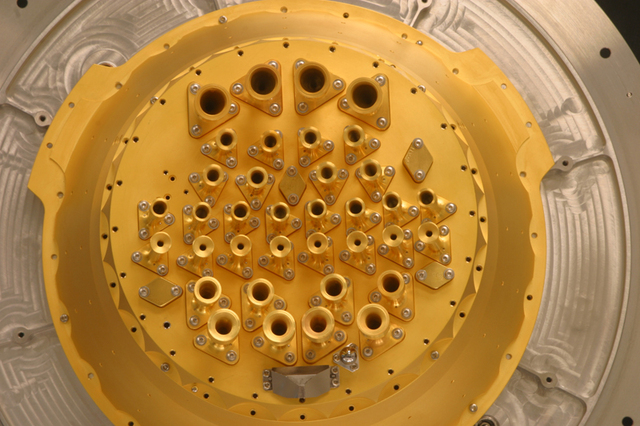High Frequency Instrument (HFI)
The High Frequency Instrument (HFI) aboard Planck uses Jet Propulsion Laboratory (JPL) spider-web and polarization-sensitive bolometers cooled to 0.1 K to map the sky in six frequency bands from 100 to 857 GHz (3 mm to 350 microns). Each of the 54 detectors in the focal plane was fabricated at JPL's Microdevices Laboratory (MDL).
A bolometer detects infrared and mm-wave light by detecting its heat, much like feeling the warmth of sunlight with your hand. The light is absorbed on the surface of the bolometer (which looks like a spider web), heating the bolometer. The resulting temperature increase of the bolometer is detected by a tiny thermometer (thermistor) in the center of the web. The change in temperature of the bolometer depends on the intensity of the incoming light.

Bolometers detect any source of heat – including cosmic ray particles that can hit the bolometer and deposit heat. The spider web design allows long-wavelength thermal radiation to be absorbed, but high-energy cosmic rays pass through. The spider web design also makes the bolometers much lighter and less sensitive to the vibrations of a rocket launch into space.
The spider web consists of 1 micron thick silicon nitride, coated with gold. The thermistor is a 30x100x300 micron slice of neutron transmutation doped (NTD) germanium, and is connected to the spider web with indium bump bonds. The spider web diameter and grid spacing varies depending on the frequency of operation of the device.
The 32 polarization sensitive bolometers (PSBs) aboard Planck can also measure the polarization of incoming light. Instead of a circular spider-web grid, a PSB consists of a square grid which is only metallized in one direction. This allows the bolometer to only absorb a single polarization of incoming radiation. Every PSB works in a pair so that each polarization sense is detected simultaneously.
The mission of Planck is to measure tiny fluctuations in the 2.7 Kelvin Cosmic Microwave Background radiation. HFI's bolometers must be cooled and operated at 0.1 Kelvin in order to minimize sources of noise. The HFI bolometers are close to the limit of background photon noise during operations at L2.
